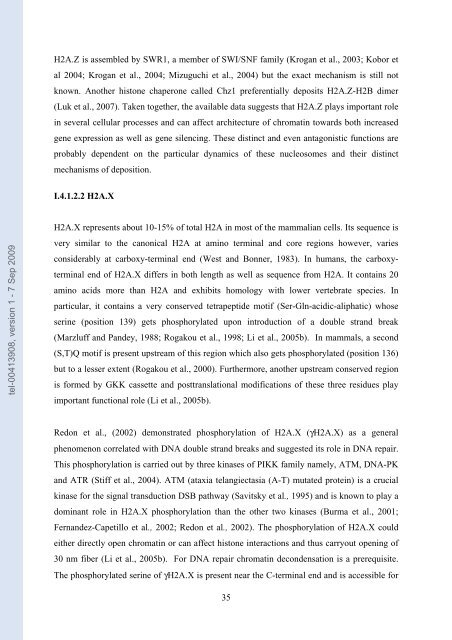Etudes sur le mécanisme de remodelage des nucléosomes par ...
Etudes sur le mécanisme de remodelage des nucléosomes par ...
Etudes sur le mécanisme de remodelage des nucléosomes par ...
You also want an ePaper? Increase the reach of your titles
YUMPU automatically turns print PDFs into web optimized ePapers that Google loves.
tel-00413908, version 1 - 7 Sep 2009<br />
H2A.Z is assemb<strong>le</strong>d by SWR1, a member of SWI/SNF family (Krogan et al., 2003; Kobor et<br />
al 2004; Krogan et al., 2004; Mizuguchi et al., 2004) but the exact mechanism is still not<br />
known. Another histone chaperone cal<strong>le</strong>d Chz1 preferentially <strong>de</strong>posits H2A.Z-H2B dimer<br />
(Luk et al., 2007). Taken together, the availab<strong>le</strong> data suggests that H2A.Z plays important ro<strong>le</strong><br />
in several cellular processes and can affect architecture of chromatin towards both increased<br />
gene expression as well as gene si<strong>le</strong>ncing. These distinct and even antagonistic functions are<br />
probably <strong>de</strong>pen<strong>de</strong>nt on the <strong>par</strong>ticular dynamics of these nuc<strong>le</strong>osomes and their distinct<br />
mechanisms of <strong>de</strong>position.<br />
I.4.1.2.2 H2A.X<br />
H2A.X represents about 10-15% of total H2A in most of the mammalian cells. Its sequence is<br />
very similar to the canonical H2A at amino terminal and core regions however, varies<br />
consi<strong>de</strong>rably at carboxy-terminal end (West and Bonner, 1983). In humans, the carboxy-<br />
terminal end of H2A.X differs in both <strong>le</strong>ngth as well as sequence from H2A. It contains 20<br />
amino acids more than H2A and exhibits homology with lower vertebrate species. In<br />
<strong>par</strong>ticular, it contains a very conserved tetrapepti<strong>de</strong> motif (Ser-Gln-acidic-aliphatic) whose<br />
serine (position 139) gets phosphorylated upon introduction of a doub<strong>le</strong> strand break<br />
(Marzluff and Pan<strong>de</strong>y, 1988; Rogakou et al., 1998; Li et al., 2005b). In mammals, a second<br />
(S,T)Q motif is present upstream of this region which also gets phosphorylated (position 136)<br />
but to a <strong>le</strong>sser extent (Rogakou et al., 2000). Furthermore, another upstream conserved region<br />
is formed by GKK cassette and posttranslational modifications of these three residues play<br />
important functional ro<strong>le</strong> (Li et al., 2005b).<br />
Redon et al., (2002) <strong>de</strong>monstrated phosphorylation of H2A.X (γH2A.X) as a general<br />
phenomenon correlated with DNA doub<strong>le</strong> strand breaks and suggested its ro<strong>le</strong> in DNA repair.<br />
This phosphorylation is carried out by three kinases of PIKK family namely, ATM, DNA-PK<br />
and ATR (Stiff et al., 2004). ATM (ataxia telangiectasia (A-T) mutated protein) is a crucial<br />
kinase for the signal transduction DSB pathway (Savitsky et al., 1995) and is known to play a<br />
dominant ro<strong>le</strong> in H2A.X phosphorylation than the other two kinases (Burma et al., 2001;<br />
Fernan<strong>de</strong>z-Capetillo et al., 2002; Redon et al., 2002). The phosphorylation of H2A.X could<br />
either directly open chromatin or can affect histone interactions and thus carryout opening of<br />
30 nm fiber (Li et al., 2005b). For DNA repair chromatin <strong>de</strong>con<strong>de</strong>nsation is a prerequisite.<br />
The phosphorylated serine of γH2A.X is present near the C-terminal end and is accessib<strong>le</strong> for<br />
35

















